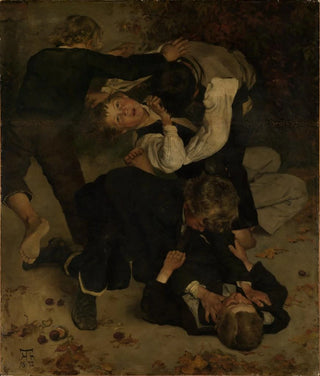Art print | Boys Fighting - Hans Thoma


View from behind

Frame (optional)
Reproduction of Boys Fighting - Hans Thoma – Captivating Introduction
In the vast panorama of art history, certain works stand out for their ability to capture the essence of humanity through poignant and evocative scenes. "Boys Fighting - Hans Thoma" is one such piece that, through its delicate approach and sensitive interpretation, invites us to reflect on the nature of youth and conflict. This painting, imbued with realism and symbolism, evokes deep emotions while immersing us in the tumultuous universe of childhood faced with war. Through the gaze of the young protagonists, the artist offers a window into universal themes such as lost innocence and bravery in the face of adversity.
Style and uniqueness of the work
Hans Thoma's style, marked by a harmonious fusion of realism and idealism, is vividly expressed in "Boys Fighting." The work is distinguished by its palette of warm, earthy colors, which evoke an atmosphere that is both nostalgic and dramatic. The figures of the young boys, sculpted with meticulous precision, seem to vibrate with palpable energy, while their expressions reveal a range of emotions from determination to anxiety. Thoma manages to transcend simple representation to create a visual narrative where every detail matters, inviting the viewer to question the underlying story. The surrounding natural elements framing the characters add an extra dimension to the work, highlighting the contrast between the beauty of the world and the brutality of combat.
The artist and his influence
Hans Thoma, an emblematic figure of 19th-century German art, established himself through his unique approach to painting. Influenced by Romanticism and Realism, he developed a style that combines attentive observation of reality with poetic sensitivity. Thoma often drew inspiration from folklore and the traditions of his country, seeking to capture the soul of rural life and German landscapes. His work "Boys Fighting" fits within this lineage, but it transcends the local context to address universal questions, touching on the human condition in its

Matte finish

View from behind

Frame (optional)
Reproduction of Boys Fighting - Hans Thoma – Captivating Introduction
In the vast panorama of art history, certain works stand out for their ability to capture the essence of humanity through poignant and evocative scenes. "Boys Fighting - Hans Thoma" is one such piece that, through its delicate approach and sensitive interpretation, invites us to reflect on the nature of youth and conflict. This painting, imbued with realism and symbolism, evokes deep emotions while immersing us in the tumultuous universe of childhood faced with war. Through the gaze of the young protagonists, the artist offers a window into universal themes such as lost innocence and bravery in the face of adversity.
Style and uniqueness of the work
Hans Thoma's style, marked by a harmonious fusion of realism and idealism, is vividly expressed in "Boys Fighting." The work is distinguished by its palette of warm, earthy colors, which evoke an atmosphere that is both nostalgic and dramatic. The figures of the young boys, sculpted with meticulous precision, seem to vibrate with palpable energy, while their expressions reveal a range of emotions from determination to anxiety. Thoma manages to transcend simple representation to create a visual narrative where every detail matters, inviting the viewer to question the underlying story. The surrounding natural elements framing the characters add an extra dimension to the work, highlighting the contrast between the beauty of the world and the brutality of combat.
The artist and his influence
Hans Thoma, an emblematic figure of 19th-century German art, established himself through his unique approach to painting. Influenced by Romanticism and Realism, he developed a style that combines attentive observation of reality with poetic sensitivity. Thoma often drew inspiration from folklore and the traditions of his country, seeking to capture the soul of rural life and German landscapes. His work "Boys Fighting" fits within this lineage, but it transcends the local context to address universal questions, touching on the human condition in its






